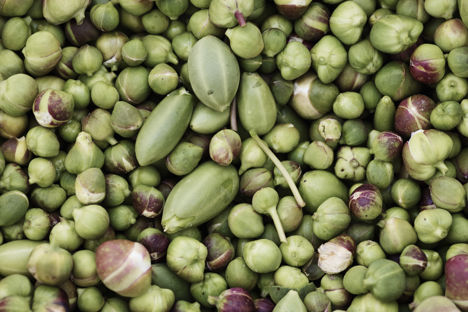
In pictures: Pantelleria – the island of capers
The best capers in the world come from Pantelleria, a small, remote Italian island far off the Sicilian coast. Find out why and see the beauty of the island for yourself in our photo story.
In pictures: Pantelleria – the island of capers
The best capers in the world come from Pantelleria, a small, remote Italian island far off the Sicilian coast. Find out why and see the beauty of the island for yourself in our photo story.
The remote, windswept island of Pantelleria sits halfway between Sicily and Tunisia. With year-round blazing sunshine, beautiful views and a relaxed, easy-going way of life, it's easy to see why the island is a favourite getaway for celebrities like Giorgio Armani and Madonna. But for the foodies of the world, it isn't the peace and quiet that makes it such a magical place – it's the capers, found growing from every nook and cranny of the island, that make the six-hour boat trip worthwhile.
La Nicchia is the company responsible for keeping the island’s caper industry (which, along with the vineyards and tourism, form the backbone of Pantelleria’s entire economy) alive. It has been exporting capers grown by local farmers since 1949, and in 2005 began growing its own, taking full control of the whole process from seed to jar. Manager Gabriele Lasagni's extensive research has led to new products such as caper powder, crispy capers and caper leaves in olive oil. He believes no part of the plant should be wasted, and that Pantelleria offers the perfect conditions for growing and harvesting capers.
‘Over the centuries, the island has naturally become home to a specific caper plant (Capparis Spinosa) that, unlike other varieties, has a few more leaves that wrap around the petals of the flower when they’re still buds,’ says Gabriele. ‘These two small leaves protect the bud, meaning the capers are more consistent in quality and flavour.’
The island is also in the middle of the ocean – 100km away from Sicily – which results in blisteringly hot days and very cold nights. This helps the caper plants develop a stronger aroma, so they’re more fragrant when picked. ‘It’s not easy to live in Pantelleria – there are incredible views and the weather is lovely but there’s not much for young people to do,’ says Gabriele. ‘It’s a small island of 8,000 people and far away from everything – you have to take a plane or ship for six hours to get to Sicily. We call it the ‘Island of the Wind’ because it’s incredibly windy here and things get blown away all the time, but there is a cinema, some restaurants, a library and a hospital.’
Traditionally, there was a severe lack of fresh water on Pantelleria. This meant capers were always stored in sea salt – produced in the Sicilian city of Trapani – instead of brine, which is the most common way of pickling capers. The moisture from the buds eventually created a pickling liquor, making Pantelleria capers stronger in flavour.
Harvesting the capers is tough work – you can’t use machinery, so the buds have to be hand-picked one at a time. ‘You have to be a true hero to work on Pantelleria,’ says Gabriele. ‘The island has always been an island of farmers, not fishermen, because it was always being invaded. This meant the inhabitants never settled on the coastline, preferring the shelter of the hills instead. We harvest roughly fourteen times every year, taking the same plant’s capers every eight days or so. The plants’ twigs lengthen from May to August and you can find the capers on top.
‘On an average day, I leave the house at 4.30am when it’s still dark and make my way through the countryside to where we grow our capers,’ he continues. ‘The harvest starts at around five and lasts until ten o’clock. It’s too hot after that time and since the plants soften in the heat, I run the risk of breaking the twigs. I then return to the field and continue picking between 5pm and 8pm.’

